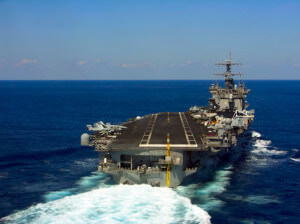The Unsinkable Navy Ship: The Origin of the Subsafe Program and its Impact on Civilian Ships Today
 CPV Manufacturing’s products meet government standards and can be found in many areas of the vessels of the US Navy. These high-quality valves and fittings are used on the heavy-duty winches, the anchor windlass of the shops, the Freon-based refrigerator and air-conditioning systems, and the elevator systems that lift aircrafts to the flight deck and in the arresting gear that catch the aircraft.
CPV Manufacturing’s products meet government standards and can be found in many areas of the vessels of the US Navy. These high-quality valves and fittings are used on the heavy-duty winches, the anchor windlass of the shops, the Freon-based refrigerator and air-conditioning systems, and the elevator systems that lift aircrafts to the flight deck and in the arresting gear that catch the aircraft.
The US Navy can’t afford to rely on a product that will fail, that’s why they’ve turned to CPV since the 1950s. CPV’s Quality Management System is certified in the areas of Design, Material, Fabrication and Testing and has been approved to meet the requirement of MIL-I-45208, SUBSAFE Level 1, EB 2678. The SUBSAFE Program was put in place after a tragic incident occurred and the USS Thresher was lost at sea in 1963.
Disappearance of Thresher
First launched in 1960, Thresher was the first ship of her class and US submarine technology with nuclear power and a modern hull design. During a deep test dive approximately 200 miles off the northeastern coast of the United State on April 10th, Thresher was lost at sea with 112 naval personnel and 17 civilians on board.
The immediate cause was unknown, so the Navy restricted all submarined until they could determine the reason behind the loss of the Thresher.
The Thresher Design Appraisal Board reviewed the Thresher’s design and provided recommendations for improvements. The exact cause of the vessel’s loss is unknown, however, it was found that there were deficient specifications, ship building practices, maintenance practices and operational procedures.
Members of the navy attribute the disappearance of the Thresher to the following:
- Thresher had 3,000 silver-brazed piping joints that were exposed to full submergence pressure. After testing these joints, results showed that fourteen percent of the joints were substandard. This indicates that possibly more than 400 joints were substandard and could have failed, resulting in the flooding of the engine room.
- The crew could not access necessary equipment to stop the flooding.
- There was saltwater spray on electrical components that caused short circuits, reactor shutdown as well as loss of propulsion power.
- The tank blow system did not operate properly and the submarine couldn’t overcome the weight of water in the engine room.
Birth of the Subsafe Program
Nearly two months after the loss of Thresher, the Subsafe Program was created and has shown a lot of success. Between 1915 and 1963, sixteen submarines were lost in non-combat causes. Since the Subsafe Program, only one submarine has been lost.
The US Navy relies on CPV Manufacturing products to deliver high quality products to keep their vessels running smoothly, and these standards far surpass commercial requirements. All CPV products are delivered to customers meeting all standards of performance, reliability and quality.
Contact us to learn more about CPV Manufacturing and their products.
